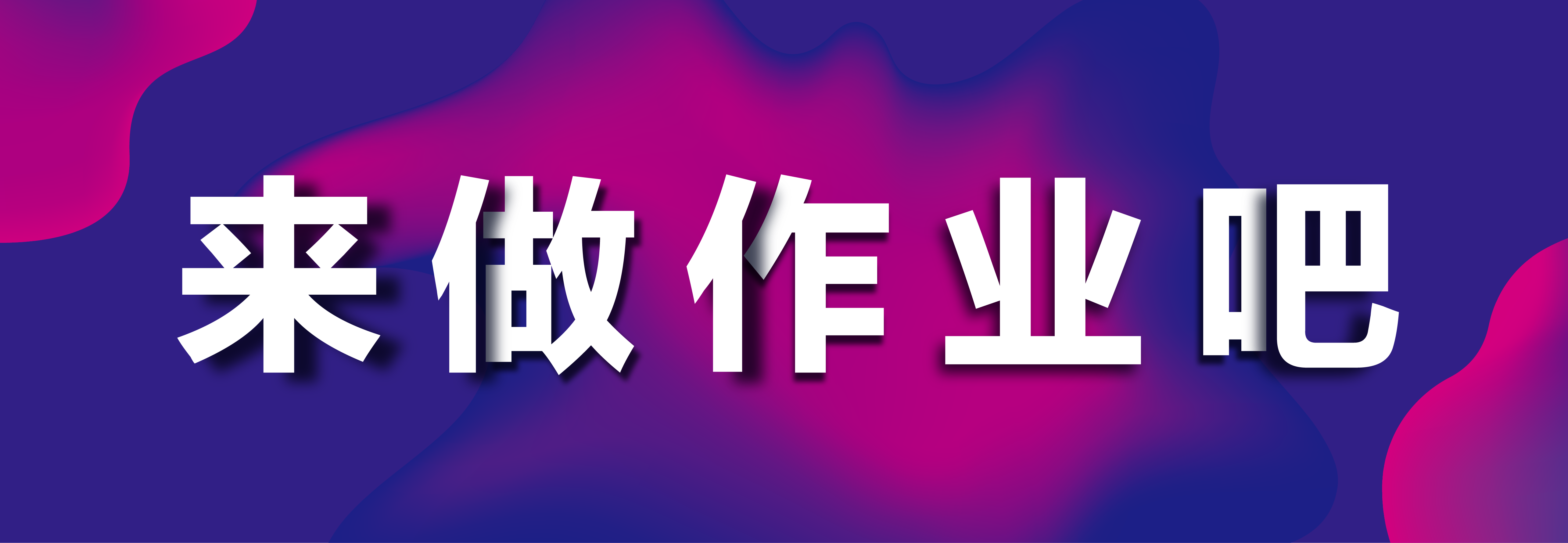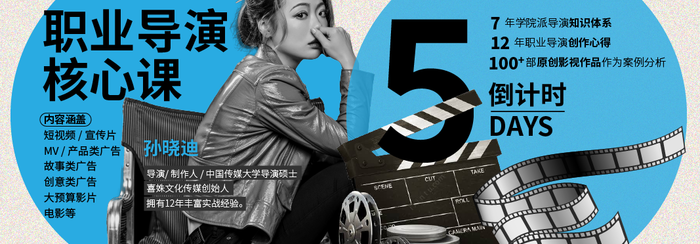跟ASC杂志学英语 | 第一期:《碟中谍6》幕后:为保持新鲜感,这个系列每集都换导演
对幕后工作做来说,ASC是一本很好的杂志,影视工业网一直在做该杂志的汉化工作,而有一部分摄影师如中伟,一直阅读的是英文原版,当他知道这件事后就想,我们为何不专门开设这样的一门课程,教摄影师们学习英语?在电影全球化的今天,摄影师们学好英语,对生活和工作都有帮助,于是有了我们今天的课程。
中伟:荷兰摄影师,2009年进入北京电影学院摄影系电影摄影专业学习,于2013年以专业第一的成绩毕业并留校,在摄影系国际班任教。作品:电影《少女哪吒》、《追·踪》;短片作品《她》《绽放》。个人代表作还包括《魔轮》《重遇涅槃》。
学习准备建议:笔记本电脑,边看直播边看杂志,也方便你划词做笔记。
插播:学习嘉年华,每天直播分享,干货知识,实用奖品,系统职业课程优惠等福利,等你来~点击图片看了解更多。
今天学习的内容是ASC杂志的9月刊,《逐影全球》(global pursuit)栏目,带你走进《碟中谍6:全面瓦解》的幕后。(杂志地址:https://cinehello.com/boards/2094)
第1段:
For the crew of writer-director Christopher McQuarrie’s FMission: Impossible – Fallout — the sixth installment in the M:I franchise — the mission they accepted was likely the most complex international production of their careers to date. The movie tracks secret agent Ethan Hunt (Tom Cruise) and his team of Impossible Missions Force operatives as they travel the world to address the unintended conse- quences of a previous operation and neutralize the dire threat posed by spy-turned-terrorist Solomon Lane (Sean Harris)and his acolytes.
M:I franchise: 不止是系列电影,还延伸出很大的生意体系,在全球都很成功。
对(Christopher McQuarrie)及其带领的摄制团队而言,该片摄制或是他们从业至今制作过最复 杂的跨国任务。影片讲述秘密特工伊桑·亨特(汤姆·克鲁 斯饰)与不可能任务行动署(IMF)的队友一起在世界各 地解决上次行动导致的意外后果,并应对曾为间谍的恐 怖分子所罗门·莱恩(肖恩·哈里斯饰)及其党羽带来的恐 怖威胁。
第2段:
“As much as possible, we wanted to show everything happening for real, rather than shooting helicopters on a process stage, for example,” says cinematographer Rob Hardy, BSC. “This movie was spread out across the globe, and there was so much happening; the script was changing daily, scenes came and went, and during all that, we had to maintain a common visual thread.”
cinematographer:不是剧组里的职务名称(DP),是摄影指导这份工作的统称。
visual thread:影调
“我们想尽可能多地呈现实拍的场景,而不仅仅是在 机动平台上拍摄直升机。”英国电影摄影师协会成员,摄 影指导罗伯·哈迪(Rob Hardy, BSC)说道。“这部影片的 拍摄地点遍及全球,故事情节丰富,剧本每天都有改动,场景可能拍了又删,而在这一切变数之中,我们视觉创作的思路仍然要保持统一。”
第3段:
Aiding the effort to ensure visual consistency across the production, all of the movie’s action was shot by the main unit, a decision that was made because Cruise performs all of his own stunts. “It was fantastic doing what would normally be second unit work so that I could put a frame around it in the same visual language as the rest of the movie,” says Hardy.
stunts:动作戏替身
second-unit :B组
main-unit :A组
影片所有动作戏都由主摄制组拍摄,确保影片在视觉上的呈现保持一致。这源于克鲁斯每个特技表演都亲自上阵的决定。哈迪说道:“这通常是第二摄制组的工作, 这次能由我们负责,真是太棒了,因为我可以用同样的视 觉语言进行拍摄,保持和其他部分的统一。”
第4段:
That choice also added to the demands on the depart- ment heads. “The scale of the movie was the biggest chal- lenge,” says gaffer Martin Smith. “So many crews and lighting lists, so much to rig and prep.” Key grip Sam Phillips concurs, summing up the shooting thus: “More cameras, more speed, more rigging, more crew, more pressure, more locations — and less time.”
rig:摄影机架设固定的过程
这个决定也提高了对各部门负责人的要求。“摄制规 模是最大的挑战。”灯光师马丁·史密斯(Martin Smith)说 道:“摄制团队庞大,布光要求很繁杂,要安装以及预备的设备非常多。”器械总监山姆·菲利普斯(Sam Phillips)总 结道:“摄影机更多、拍摄速度要求更快、器械更多、组员更多、压力更大、实景地点更多,唯独时间更少。”
第5段:
In total, principal photography spanned slightly more than a year — a schedule that was extended after Cruise broke his ankle while filming a stunt, resulting in a two-month hiatus — with stops in Paris, France; London, England; Queenstown, New Zealand; and Abu Dhabi and Dubai, United Arab Emirates. “Due to the hiatus, the end date shifted,” says Hardy. “In terms of the camera equipment, there was a question about whether the production would be willing to pay to keep every- thing in place for consistency, which they did. Another issue, of course, was the weather when we were trying to match things we shot previously.”
end date:杀青日
shifted:推迟
完成主要拍摄任务计划耗时一年多,这是因为克鲁斯在一场特技戏中脚踝受伤,导致摄制暂停了两个月, 在法国巴黎、英国伦敦、新西兰昆士 兰及阿联酋阿布扎比和迪拜的拍摄被推迟。哈迪表示:“由于中途暂停, 杀青的日子便推迟了。这在摄影设备 方面带来的问题就是,制片组是否愿意花钱让它们持续待命,他们确实这么做了。那么另一个问题当然就是当 我们尽力接续之前拍摄的镜头时,天气状况是否匹配。”
第6段:
Fallout marked the first collabora- tion between Hardy and McQuarrie, the latter of whom was returning to the franchise after writing and directing the previous installment, Mission: Impossible – Rogue Nation (AC Aug. ’15), on which he had worked with cinematographer Robert Elswit, ASC. “I loved working with Bob,” says McQuarrie, “but every [previous] installment of Mission: Impos- sible has had a new director, each very different from the last. That has become a defining characteristic of the series. When Tom asked me to return, I said I would on the condition that we maintain that sensibility. In short, that meant I needed to be ‘another director’ — and to that end, I needed to make a film as unlike Rogue Nation as possible, both in look and tone. So, with very few exceptions, I replaced my entire crew. Rob Hardy came to my attention through his work on Ex Machina [AC May ’15], a beautiful film that is about as far from Rogue Nation as can be.”
Fallout:一个重点失误延伸出来的现象
《全面瓦解》见证了哈迪和迈考利的首次合作。此次是迈考利继担任 《碟中谍5:神秘国度》(15年8月 刊)编剧兼导演后再度回归《碟中谍》系列,拍摄《碟中谍5》时,他 的合作对象是来自美国电影摄影师协 会的摄影指导罗伯特·埃尔斯维特 (Robert Elswit, ASC)。“我很乐于同 罗伯特合作。”迈考利说道:“之前的 每一部《碟中谍》系列电影都由不同的导演执导,这也是该系列的显著特点。汤姆邀请我回归时,我提出的条件是保留这种识别度。简言之,这也就意味着我得成为‘另一名导演’。为此,我要尽量拍出一部在视觉风格及整体基调方面和《神秘国度》迥异的电影。因此,除了极个别的特例外, 我几乎替换了整个摄制组。我注意到 罗伯·哈迪是因为他拍摄的《机械 姬》(15年5月刊),那部影片堪称精品,且与《神秘国度》风格大相 径 庭。”的确,哈迪向导演坦言,他偏爱 广角拍摄,《机械姬》几乎全片都是用32mm和50mm镜头拍摄的。“于我 而言这简直难以想象。”迈考利回忆 道:“我意识到,我们来自两个截然 不同的极端,却又汇合于此,可能会带来独特的成果。”
第7段:
Indeed, Hardy told the director up front that he preferred wide angles, pointing out that Ex Machina was shot almost entirely using 32mm and 50mm lenses. “That was unimaginable to me,” McQuarrie recalls. “I realized we were coming at this from two different ends of the spectrum, and the result might be special.”
wide angles:广角
spectrum:光谱、范围
“这是一个阴暗的故事,所以罗伯想要在画面上突出阴暗感。”史密斯谈到:“他希望汤姆出现在阴影 中,而不总是处于光亮中,那会显得平淡。最终我们的布光精细且轮廓鲜明、出现在画面中的光源优美悦目, 一致的色调贯穿全片。诀窍就是,让一切显得真实。别总是给本就惊艳无比的场景再额外布光了。”
第8段:
Hardy adds that where the two immediately joined minds was on the need to “absolutely do our own thing, to reinvent the look of the franchise — although Chris and Tom did say, ‘Remember, it’s Mission: Impossible!’ To me, though, that meant it was open to interpretation. The key thing for Tom was he wanted the movie to feel dark and moody, edgier than the previous films. I would say we tried to be more immersive — and when I say ‘immersive,’ I mean there is an authenticity to it. That was always part of my manifesto: I wanted the audience to feel and believe in the drama. But at the same time, it’s cinema of an epic nature. It hearkens back to a slightly older style of filmmaking, with reference points like The French Connection and All the President’s Men. We tried for a more classical feel.”
immersive:浸入感
哈迪表示,当谈及“要完全原创,彻底改造《碟中谍》系列的视觉风格”时,他和导演可谓一拍即合。 虽然克里斯和汤姆都强调说:‘别忘 了,这可是《碟中谍》!’但对我而言,那意味着多种解读方式。汤姆重视的是电影要呈现阴暗忧惧之感,要比前几部更显锋芒。我则会说,我们要努力增强浸入感。‘浸入感’意思就是要有真实感。这一直是我的信条之 一。我希望观众感受和相信片中的戏剧性事件。但同时这部电影又是自带 史诗属性的。我们回归到了一种稍微老式的电影创作风格,参照了《法国贩毒网》及《总统班底》等电影的元素,尝试呈现出更为古典的韵味。”
图注:
Hunt and Walker approach the drop zone for their high altitude, low opening (HALO) jump.
亨特与沃克接近伞降地域,准备进行 HALO跳伞(高空投下低空开伞)。
high altitude, low opening:高跳低开
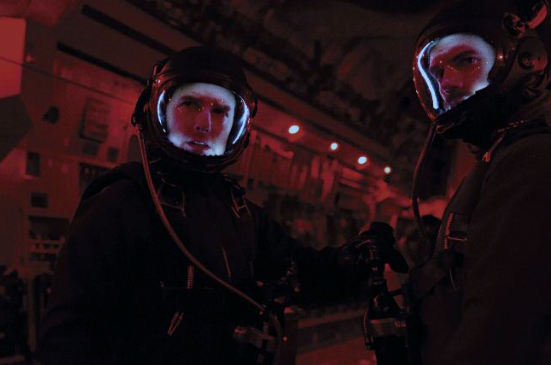
Cruise prepares for a practice jump alongside McQuarrie.
迈考利身旁的克鲁斯准备练习跳伞。
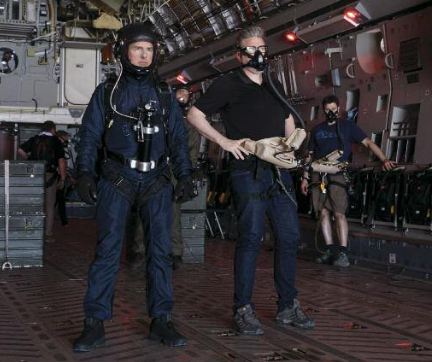
Cruise plummets toward the Earth.
克鲁斯朝地面坠去。
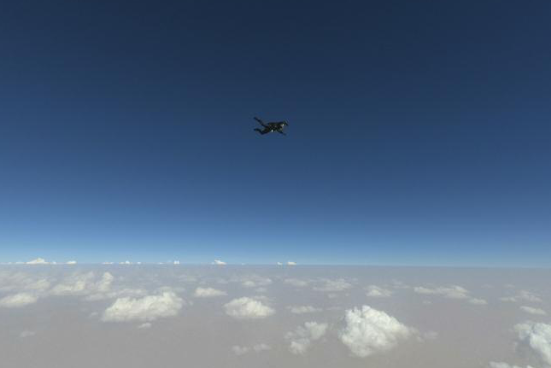
第9段:
“It’s an underlying story of dark situations, so Rob wanted darkness,” Smith relates. “He wanted Tom in shadows, not to always light him flat. We ended up with nice, edgy lighting; beautiful practicals; and color tones that run through the entire movie. The whole key was, ‘Let’s have it look real. Don’t always put a light where it would look the prettiest.’”
light him flat:一种平光的打光方式
edgy lighting:轮廓鲜明的光
“这是一个阴暗的故事,所以罗伯想要在画面上突出阴暗感。”史密斯谈到:“他希望汤姆出现在阴影中,而不总是处于光亮中,那会显得平淡。最终我们的布光精细且轮廓鲜明、出现在画面中的光源优美悦目, 一致的色调贯穿全片。诀窍就是,让 一切显得真实。别总是给本就惊艳无比的场景再额外布光了。”
第10段:
In keeping with the “classical feel,” Cruise, McQuarrie and Hardy also wanted to shoot Fallout on 35mm film. “Movies are dreams, and dreams are not 8K digital — not mine anyway,” McQuarrie says. “I’m not looking for reality; I’m looking for realism. Most of all, I was looking to create the beautiful, grainy, gauzy look of the films I grew up watching as a child in the 1970s.”
classical feel :经典电影的感觉
reality:现实
realism:现实主义,真实的感受
和哈迪希望使用35mm胶片进行拍摄。“电影如梦境,而梦境绝非8K数字摄影机的效果那样清晰,至少我 的梦境不是。”迈考利说道:“我寻找的不是现实,而是现实主义。最重要的是,我期待创造出美妙、具有颗粒感的、薄纱般的视觉风格,正如上世纪70年代、我仍是孩童时观看的那些电影一般。”
第11段:
Hardy agrees with the sentiment. “To me, shooting film takes you back to a different style of filmmaking, much more classical and elegant,” he says. “We shot 90 percent of the movie on film —
anamorphic, primarily with [Panavision] C Series lenses, and some work with E Series lenses. And then we added an Imax element [for two major aerial sequences], but we realized that shooting Imax film would be impractical. In the end, we decided to use a large digital format for that material, and after some testing, we chose [Panavision’s] Millen-nium DXL1 [and Red Digital Cinema’s Weapon Dragon 6K].”
anamorphic:变形宽银幕镜头
aerial sequences:空中戏份
哈迪同意这一观点。“我认为, 胶片摄影让人回归到一种不同的电影创作风格。这种风格更加古典、更为优雅。”他说:“90%的画面都是使用胶片配合变形宽银幕镜头拍摄的,主分E系列镜头。我们还计划为两段发生在空中的重头戏加入Imax元素,但又意识到拍摄胶片Imax并不具有实操性。最后,我们决定使用大画幅数字格式来拍摄那部分的内容。通过多番测试后,我们选定用Panavision Millen- nium DXL1和Red的Weapon Dragon 6K 摄影机进行拍摄。”
第12段:
These aerial sequences — which open up to the 1.9:1 aspect ratio when viewed in an Imax theater — were shot spherically with Panavision Primo 70 lenses. The Weapon Dragon 6K, with C Series anamorphics, was also employed for some specialized work in Paris’ Grand Palais. The DXL and Red cameras all recorded Redcode Raw files to Red Mini-Mags at 3:1 compression.
spherically :球面镜头(球面的)
这些发生在空中的戏份,是用 Panavision Primo 70镜头拍摄的,在 Imax银幕上,这些片段会以1.9:1的画 幅宽高比呈现。在巴黎大皇宫拍摄一 些特殊镜头时,剧组还用上了装配C 系列变形宽银幕镜头的Weapon Dragon 6K摄影机。DXL和Red摄影机均以Redcode Raw格式录制,素材存储至Red Mini-Mag储存卡中,压缩比为3:1。
第13段:
The bulk of the movie was shot using Panavision Millennium XL2 film cameras. Hardy selected Kodak Vision3 50D 5203 negative for much of the Paris work and some additional exteriors; Vision3 200T 5213 for the bulk of the New Zealand exteriors and a couple of sets built onstage at Leavesden Studios near London; and Vision3 500T 5219 for night work as well as in tunnels and other dark locations.
影片的大多数画面是用Panavision Millennium XL2胶片摄影机拍摄的。 在巴黎和一些额外外景拍摄时,哈迪选用的胶片是Kodak Vision3 50D 5203彩色负片; 在新西兰外景和伦敦利维斯登影棚中的场景拍摄时用的是 Vision3 200T 5213;拍摄夜景、隧道、 光线昏暗场景时用的则是Vision3 500T 5219。
第14段:
The C Series anamorphics “were our hero lenses,” says 1st AC Jennie Paddon, who was on for prep and worked the Paris portion of the shoot before departing on pregnancy leave, at which point she passed the baton to Adam Coles. “We also carried the C Series’ adapted close-focus lenses,” she notes.
1st AC:摄影大助
C系列变形宽银幕镜头“是我们镜头中的英雄”,第一摄助珍妮·帕登 (Jennie Paddon)说,珍妮负责准备工作和巴黎部分的拍摄,后因产假离组,接力棒便被递给了亚当·科勒斯 (Adam Coles)。她还指出:“我们也携带了C系列的适配近焦镜头。”
图注:
Shot during an actual free-fall, the HALO jump was designed to look like one continuous take but was actually realized in three discrete phases, each of which required a week to execute.
自由落体期间实拍HALO跳伞。该镜头看似一镜到底,其实分三期完成,每期需耗时一周。
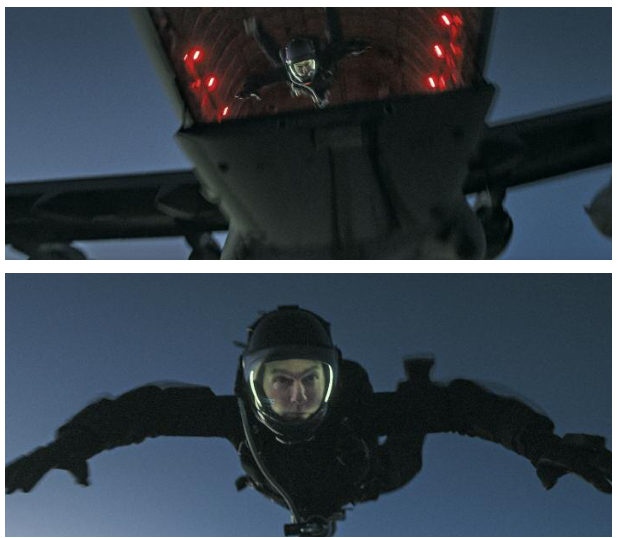

第15段:
Film rushes were sent to Cinelab London for processing, and then to Pinewood Digital for 4K scanning and dailies creation. Pinewood Digital provided location dailies setups in New Zealand and Norway, and provided 4K delivery for all review and editorial media; every morning, Pinewood Digi- tal would send 4K DNxHD MXF files to Hardy’s regular digital-imaging tech- nician, Jay Patel, and later to DIT and color coordinator Joe Steel, who took over when Patel had to leave during the hiatus. The filmmakers primarily reviewed digital dailies on set, although while shooting in Paris to start the production, they periodically watched film dailies on a rented cinema screen.
每天拍出的胶片会被送到Cinelab London冲印,然后在Pinewood Digital 进行4K扫描并生成每日样片。 Pinewood Digital也为在新西兰和挪威的拍摄提供驻组每日样片的制作服务,并且他们会输出4K文件,供审阅 及剪辑方面使用;每天早晨, Pinewood Digital会 把 4K分辨率的 DNxHD MXF 视频文件发送给与哈迪长期合作的数字影像技师杰·帕特尔 (Jay Patel),后来帕特尔在摄制暂停期间离开剧组,数字影像技师兼调色协调员乔·斯蒂尔(Joe Steel)就接替 了他的工作。影片主创在剧组里主要还是以数字形式检查每日样片,但在巴黎拍摄部分开始的时候,他们还是阶段性地在租来的影院银幕上观看胶片印出来的样片素材。
第16段:
“I reviewed dailies on the same monitors I used for the live digital scenes,” explains Steel, who worked on set with Blackmagic Design’s DaVinci Resolve. “Stills of the color-timed dailies were then uploaded onto an iPad so that Rob could easily review them on set. He would give feedback, and I would adjust [the stills] accordingly and return color references to Pinewood Digital if there were any adjustments to be made.”
“我用来检查每日样片的显示器,就是在拍摄时同步监看的显示器,”斯蒂尔解释说,他在片场使用 Blackmagic Design的DaVinci Resolve软件工作。“从调过色的每日样片里截出的静帧会被上传至iPad,以便罗伯在片场观看。罗伯会给出反馈,我会根据他的意见对静帧进行相应的调整, 若还需添加其它调整,色彩参考就会被传回到Pinewood Digital。”
第17段:
The production primarily shot with at least three cameras. Digitally captured material was monitored on Sony PVM-A250 25" OLED moni- tors; LUTs and CDLs were applied using Pomfort LiveGrade software and Fujifilm IS-Mini LUT boxes. All digital material was backed up to a Promise Technology Thunderbolt RAID system via Pomfort’s Silverstack media- management software.
摄影机拍摄的素材通过Sony的 PVM-A250 25寸 OLED监视器监看; LUT和CDL通过Pomfort LiveGrade软件 和Fujifilm IS-Mini LUT盒加载。所有素材经由Pomfort 的 Silverstack媒体管理软件备份至 Promise Technology Thunderbolt RAID硬盘阵列系统。
第18段:
The production’s LUTs were created at London facility Molinare, where colorist Asa Shoul would later handle the final digital color grade. According to Steel, “There were only two LUTs that we used: a master LUT for the DXL camera, and one that matched the Red Weapon to the DXL. All other digital color grading was done with CDLs, which we did on set to either create a new look or match to film.”
Molinare公司制作的,调色师艾莎·索尔(Asa Shoul)也是在该公司进行最终的数字调色。斯蒂尔表示,“我们只 用了两种LUT:一种是DXL摄影机使用的主要LUT,另一个LUT的用途则是将Red Weapon摄影机的画面与DXL 匹配。其余所有数字调色都是用CDL在片场完成的,要么是为了创造新的视觉风格,要么是为了匹配胶片拍出 的画面。”
现场提问环节
这些单词如何临场运用?
先学,跟着念,为什么我强调中伟老师带着跟大家念呢?不要管你懂不懂,就是跟着念。因为中英发音用到的肌肉不一样,所以我们要要强制打开(念英文)肌肉,养成习惯。
宽银幕播放电影对后期制作审查时,如key像roto的边缘像素,有必要卡像素卡的那么严重吗?
很多时候选变形宽荧幕不是要更多像素,是为了最后的画面,效果跟球面镜头是完全不一样的。而像素卡得是否严重还要看具体情况。
想更多了解灯光的术语和行话。
不一样的灯具有不一样的名称,我们说的2K,5K,美国那边也可以这么说。直接把数字翻译成英文就好,这个内容很多,后期我们也可能专门开一期讲。
点击图片完成作业↓
视频限时免费,除了文章中讲到的单词,还有主持人和中伟聊到的美国电影的工业化流程,欢迎观看。
直播/讲座
查看更多 >-
冷暖光影下的冷暖人生---《小丑》中冷暖光线对人物塑造的3个层阶
-
剧组有料:从美学电影调度等多个角度如何看待长镜头拍摄
-
剧组有料:从摄影师的角度如何完成诗意化的表达
-
剧组有料:对电影空间的认知和观念
-
剧组有料:对于拍摄时的两台不同设备影像的匹配程度有何看法?

